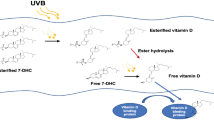Summary
The metabolism of the radioactively labeled tumor promoting phorbol esters (TPA and PDD) and of the inactive epimer of PDD (4α-PDD) were studied 12 h after topical application on the back skin of mice. The results obtained were compared with metabolic changes of the labeled phorbol derivatives after in vitro incubation with embryonic mouse skin and with cultures of HeLa and L-cells.
In mouse skin PDD and 4αPDD are poorly metabolized within 12 h as was shown previously for TPA.
In monolayer and suspension cultures of HeLa cells where at very low concentrations (10−8M) only phorbol esters with tumor promoting activity in mouse skin block DNA synthesis and stimulate choline incorporation into lipids, hardly any metabolic changes were observed in biologically active as well as in inactive phorbol derivatives. In monolayer and suspension cultures of L-cells all phorbol derivatives tested are metabolized to a considerable extent within 12 h, which correlates with the lack of response in blocking DNA synthesis and stimulation of lipid turnover.
From these results it is concluded that tumor promoting phorbol esters need no metabolic activation.
Zusammenfassung
Der Stoffwechsel der radioaktiv markierten und tumorpromovierenden Phorbolester TPA und PDD, sowie des zu PDD epimeren und inaktiven 4α-PDD, wurde 12 Std nach topischer Applikation auf die Rückenhaut von Mäusen untersucht. Die Ergebnisse werden mit dem Stoffwechsel von Phorbolderivaten nach in vitro Inkubation mit embryonaler Mäusehaut und mit Zellkulturen von HeLa-sowie L-Zellen verglichen.
Wie bereits früher im Falle von TPA festgestellt, werden in der Mäusehaut auch PDD und 4α-PDD innerhalb von 12 Std kaum metabolisch verändert.
In Monolayer-und Suspensions-Kulturen von HeLa-Zellen, wo nur die tumor-promovierenden Phorbolderivate bereits in sehr niedrigen Konzentrationen (10−8M) die DNA-Synthese blockieren und den Einbau von Cholin in Phospholipide stimulieren, wurden nur geringe metabolische Veränderungen der getesteten Phorbolderivate beobachtet. Nach Inkubation mit Monolayer-und Suspensionskulturen von l-Zellen, die diese Beeinflussung des DNA-und Lipidstoffwechsels durch Phorbolderivate nicht zeigen, werden dagegen alle hier untersuchten Phorbolderivate innerhalb von 12 Std in erheblichem Ausmaß metabolisiert.
Die erhobenen Befunde sprechen gegen eine metabolische Aktivierung von Phorbolestern.
Similar content being viewed by others
References
Barka,T., Anderson,P.J.: Histochemistry: Theory, practice and bibliography, p. 265–269. London: Harper and Row 1963
Bresch,H., Kreibich,G., Kubinyi,H., Schairer,H.U., Thielmann,H.W., Hecker,E.: Über die Wirkstoffe des Crotonöls. Z. Naturforsch. 23b, 538–546 (1968)
Freienstein,C., Freienstein,S., Kreibich,G., Kinzel,V., Süss,R.: Thymidine incorporation into HeLa cells increased by tumor-promoting croton oil factor TPA. Naturwissenschaften 57, 675–676 (1970)
Hecker,E.: Cocarcinogenic principles from the seed oil of croton tiglium and from other euphorbiaceae. Cancer Res. 28, 2338–2349 (1968)
Hecker,E.: Isolation and characterization of the cocarcinogenic principles from croton oil. In: Busch,H. (Ed.): Methods in Cancer Research, Vol. IV p. 439–484. New York-London: Academic Press 1971
Hecker,E., Bresch,H.: Incorporation of thymidine uridine and leucine, in the skin of mice after treatment with croton oil factor A1 (TPA). Proc. Amer. Ass. Cancer Res. 10, 37 (1969)
Hennings,H., Boutwell,R.K.: Studies on the mechanism of skin tumor promotion. Cancer Res. 30, 312–320 (1970)
Holt,S.J.: The value of fundamental studies on staining reactions in enzyme histochemistry, with reference to indoxyl methods for esterases. J. Histochem. Cytochem. 4, 541–554 (1956)
Jacobi,P., Härle,E., Schairer,H.U., Hecker,E.: Zur Chemie des Phorbols, VI, 4α-Phorbol. Justus Liebgis Ann. Chem. 741, 13–32 (1970)
Janoff,A., Klassen,A., Troll,W.: Local vascular changes induced by the Co-carcinogen, phorbol myristate acetate. Cancer Res. 30, 2568–2571 (1970)
Kinzel,V., Kreibich,G., Süss,R.: Metabolic effects of phorbol derivatives in HeLa cells. Proc. Amer. Ass. Cancer Res. 13, 103 (1972)
Kinzel,V., Süss,R., Kreibich,G.: In preparation (1974)
Kreibich,G., Hecker,E.: On the active principles of croton oil. X. Preparation of Tritium labeled croton oil factor A1 and other tritium labeled phorbol derivatives. Z. Krebsforsch. 74, 448–456 (1970)
Kreibich,G., Hecker,E., Süss,R., Kinzel,V.: Phorbol ester stimulates choline incorporation into mouse skin lecithine by tumor-promoting croton oil factor TPA. Naturwissenschaften 58, 323 (1971 a).
Kreibich,G., Witte,I., Hecker,E.: On the biochemical mechanism of tumorigenesis in mouse skin IV. Methods for determination of fate and distribution of phorbol ester TPA. Z. Krebsforsch. 76, 113–123 (1971 b)
Mathews,J.S.: Steroids, CCXXIII. Color reagent for steroids in thin layer chromatography. Biochim. biophysica Acta (Amst.) 69, 163–165 (1963)
Rohrschneider,L.R., Herzog,D.K., Boutwell,R.K.: Phospholipid metabolism in mouse skin following promotion. Proc. Amer. Ass. Cancer Res. 12, 79 (1971)
Süss,R., Kinzel,V., Kreibich,G.: Cocarcinogenic croton oil Factor A1 stimulates lipid synthesis in cell cultures. Experientia (Basel) 27, 46–47 (1971)
Süss,R., Kreibich,G., Kinzel,V.: Phorbol esters as a tool in cell research. Europ. J. Cancer 8, 299–304 (1972)
v. Szczepanski,Ch., Schairer,H.U., Gschwendt,M., Hecker,E.: Zur Chemie des Phorbols. III. Mono-und Diacetate des Phorbols. Justus Liebigs Ann. Chem. 705, 119–210 (1967)
Thielmann,H.W., Hecker,E.: Beziehung zwischen der Struktur von Phorbolderivaten und ihren entzündlichen und tumorpromovierenden Eigenschaften. In: Schmidt,C.G., Wetter,O. (Hrsg.): Fortschritte der Krebsforschung, Bd. VII, S. 161–197. Stuttgart-New York: Schattauer 1969
Author information
Authors and Affiliations
Additional information
IVth Communication: Z. Krebsforschung 76, 113–123 (1971)
Rights and permissions
About this article
Cite this article
Kreibich, G., Süss, R. & Kinzel, V. On the biochemical mechanism of tumorigenesis in mouse skin. V. studies of the metabolism of tumor promoting and non promoting phorbol derivatives in vivo and in vitro . Z. Krebsforsch. 81, 135–149 (1974). https://doi.org/10.1007/BF00304153
Received:
Accepted:
Issue Date:
DOI: https://doi.org/10.1007/BF00304153




